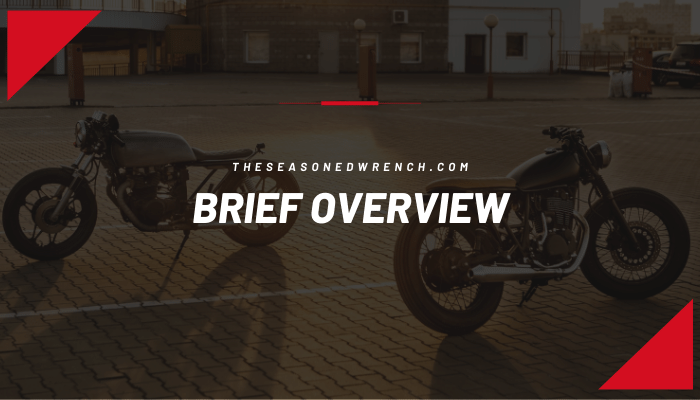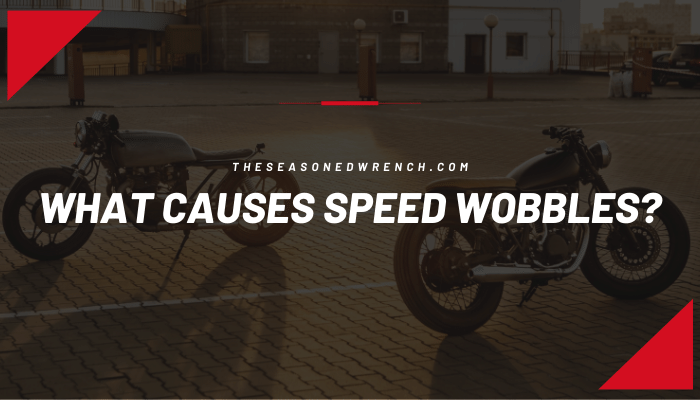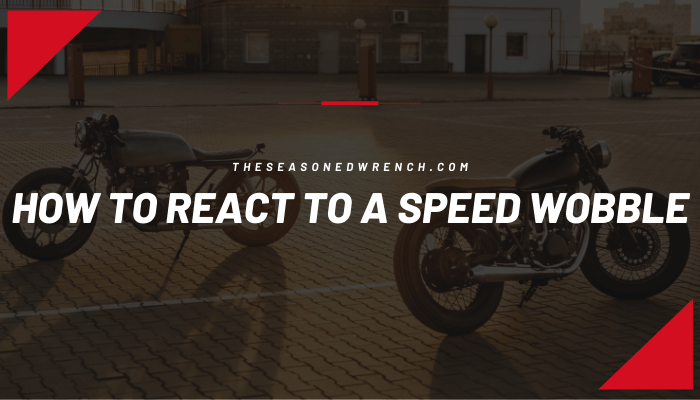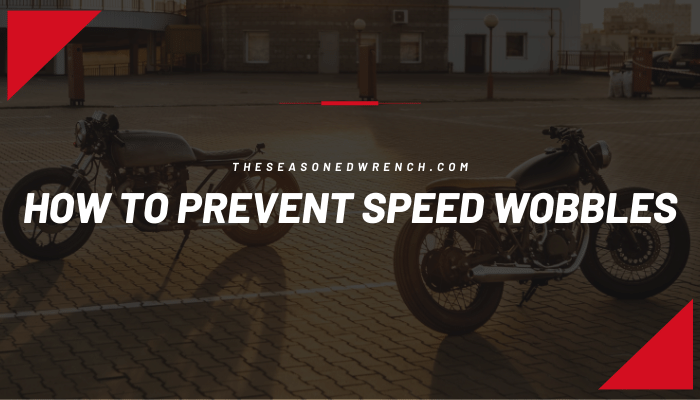Speed wobbles, tank slappers, or death wobbles can be a terrifying experience for any motorcycle rider. These abrupt and violent lateral movements of the front wheel can lead to a loss of control and potentially serious accidents. In this comprehensive guide, we will discuss the causes of speed wobbles, how to react when they occur, and most importantly, how to avoid and prevent them in the first place. Gear up and ride safe!

What Are Speed Wobbles?
A speed wobble, also known as a death wobble, is a phenomenon where the motorcycle’s front tire and handlebars oscillate rapidly, causing it to shake uncontrollably. This speed wobbling often occurs at high speeds and can be extremely dangerous, especially if the rider is not prepared to handle the situation. Speed wobbles can cause you to lose control and lead to serious accidents if not addressed promptly.
What Is A Tank Slapper?
A tank slapper is another term for a speed wobble, named for the violent back-and-forth movement of the handlebars that can cause them to hit the motorcycle’s gas tank. This can be equally dangerous and scary for the rider, as it can result in a loss of control and potential injury for the rider and those in the immediate area.

What Causes Speed Wobbles?
Speed wobbles can be caused by various factors, including environmental conditions, mechanical issues, and rider error. Understanding these causes can help you take the necessary steps to prevent and handle speed wobbles effectively.
Environmental Factors
- Uneven road surfaces: Hitting bumps, potholes, or uneven surfaces at high speeds can cause the front wheel to lose traction momentarily, leading to a speed wobble.
- Wind gusts: Strong wind gusts can affect the aerodynamics of your motorcycle, causing it to wobble at high speeds.
- Grooves in the road: Riding in the grooves created by heavy vehicles or road construction can cause your tires to bounce from one side to the other, leading to a wobble.
Mechanical Factors
- Poor tire inflation: Incorrect tire pressure can result in reduced traction and handling, making your motorcycle more susceptible to speed wobbles. Using the correct tire pressure if advised at all times.
- Worn or improperly fitted tires: Tires with uneven wear or improper fitment can cause instability and wobbling at high speeds. Additionally, properly fitted tires are paramount in avoiding an uneven weight distribution when on the bike.
- Loose or worn steering head bearings: These bearings play a crucial role in maintaining stability and control. If you have a loose steering bearing, your motorcycle may be more prone to speed wobbles.
- Chain misalignment or improper adjustment: A misaligned or improperly adjusted chain can cause uneven forces on the rear wheel, leading to wobbling at high speeds.
Rider Input
- Heavy acceleration: Rapid acceleration, especially on powerful motorcycles with short wheelbases and aggressive geometry, can increase the chances of a speed wobble by compressing the rear suspension, raising the front tire, and reducing the contact the front wheel has with the ground.
- Incorrect body position: Leaning too far back or maintaining an improper riding position can affect your motorcycle’s weight distribution and stability. Avoid an uneven weight distribution at all times.
- Overcorrecting after hitting a bump or obstacle: Overcorrecting your steering after hitting a bump or obstacle can cause a wobble, as the front wheel may not be aligned properly with the direction of travel.
Rider Experience
In most cases, the uncontrollable shaking began at certain speed intervals – usually over the speed limit – so keep this in mind, relative to your experience, to avoid these close-call head shakers.

How Should You React To Speed Wobbles?
If you find yourself in the midst of a high speed wobble, it’s essential to remain calm and follow these steps:
- Gently roll off the throttle: Do not abruptly close the throttle or accelerate, as this can make things worse. Gradually reduce your speed by easing off the throttle. If the speed wobble does not stop, progressively roll onto the throttle. If you’re at relatively low speeds, you may let the engine braking slow the bike as long as the handlebars are under control.
- Keep a neutral grip on the handlebars: Hold the handlebars firmly but avoid fighting the wobble. Allow the motorcycle to correct itself without applying too much force in either direction. As we know, motorcycle handlebars are operated through counter steering; however, during a speed wobble, adding too much weight to either side of the bike can cause a large overreaction due to the circumstances at hand.
- Lean forward slightly: Shift your weight forward and downward, as this can help stabilize the motorcycle and improve traction on the front wheel.
- Do not apply the brakes: Braking during a speed wobble can make things worse and lead to a loss of control. Focus on gradually reducing speed through engine braking and only use the rear brake if absolutely necessary.
Related: Motorcycle Popping on Deceleration? Know This (2023)
Applying The Bike’s Rear Brake
In some scenarios, it’s acceptable to use the bike’s rear brake to slow down the bike – but it does come with its own risks. When using the rear brake, the rear tire will have a more compromised level of traction, since the front end is lifted on the ground you will experience a higher probability that you lose control – should the rear tire become compromised.

How Can You Prevent Speed Wobbles?
Fortunately for us, there are many steps we can take to avoid speed wobbles before they occur. This involves some routine maintenance practices, but also some aftermarket upgrades that will make a bike less prone to speed wobbles. Keep reading to find out exactly.
Regular Bike Maintenance
Regularly inspect and maintain your motorcycle to ensure that all components are in good working order. Check for any signs of wear, damage, or loose parts that could affect stability and handling, including:
- Tire condition and inflation
- Chain alignment and tension
- Suspension components, such as fork oil levels and rear shock absorber settings
- Steering head bearings and play in the handlebars
Checking The Steering Head Bearings
What Are The Steering Head Bearings?
The steering head bearings are critical components that allow the front forks and handlebars to rotate smoothly and maintain proper alignment. They are located at the top and bottom of the motorcycle’s steering head and play a crucial role in maintaining stability and control.
The Steering Head Nut
Regularly check the tightness of the steering head nut, as a loose nut can cause excessive play in the handlebars and contribute to speed wobbles. Make sure the nut is properly torqued and adjusted according to your motorcycle’s specifications.
Checking The Components Of The Front Wheel
Forks & Triple Trees
Inspect the forks and triple trees for any signs of damage, wear, or misalignment. Ensure that the forks are properly aligned with the front end and have the correct amount of oil, as this can affect stability and handling at high speeds.
Axle Play
Check for any play or lateral axle movement in the front axle by lifting the front wheel off the ground and moving it side to side. If there is excessive play or lateral movement, it may indicate worn or damaged wheel bearings, which can contribute to high speed wobbles.
What Is Lateral Axle Movement?
Lateral axle movement, in other words, is any movement that is side-to-side or left-to-right.
Related: What To Check After Dropping Motorcycle
Aftermarket Preventative Measures and Upgrades
If you’re still concerned about speed wobbles despite regular maintenance and proper riding techniques, consider investing in aftermarket upgrades such as a steering damper or stabilizer. These devices can help your bike reduce the likelihood of speed wobbles by adding resistance to the steering, making it more stable at high speeds.
You can find a steering dampener in two typical variations:
- a steering head mounted steering dampener
- a push-rod style steering dampener
In both cases, the effect of the steering damping is the same but the cost and fitment options, depending on your motorcycle, will vary.
Riding Awareness
Finally, always maintain awareness of your surroundings and ride within your skill level. Avoid sudden acceleration, abrupt maneuvers, abnormally slow speeds, and excessive speeds, especially on unfamiliar or uneven road surfaces. By practicing safe and responsible riding habits, you can significantly reduce the risk of experiencing a speed wobble.
Read next: Why Won’t My Dirt Bike Start?
Conclusion
Speed wobbles can be a frightening experience for any rider, but with proper maintenance, awareness, and riding techniques, you can minimize your risk, ensure a safer ride, and prevent speed wobbles.
Remember to regularly inspect your motorcycle, adjust your riding style as needed, and consider aftermarket upgrades if necessary. Stay safe and enjoy the thrill of the open road!